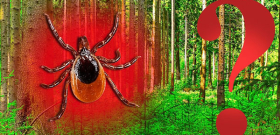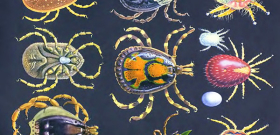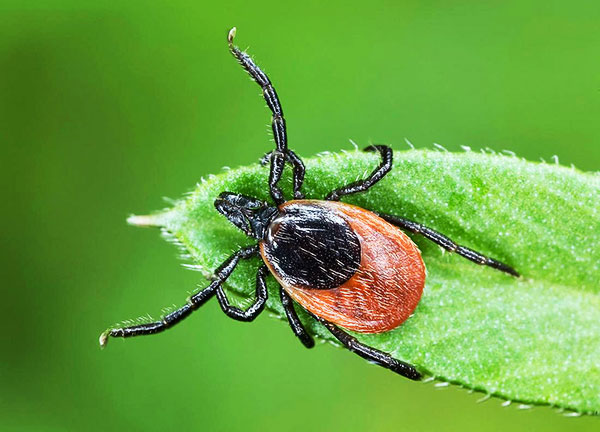
Ixodid ticks (lat. Ixodoidea) are temporary parasites that feed on blood. They live all over the world, hunting mammals, birds, reptiles. A person often becomes their victim. Do not underestimate the danger lurking in the bite of this small arthropod, which can be a carrier of dangerous infectious diseases.
Let's figure out exactly how ticks attack a person and what helps them find their victims. This will help to develop simple rules of behavior in nature, adhering to which you can avoid the unpleasant consequences of meeting with these bloodsuckers.
Habitat and season of activity of ticks
It is worth noting that the Ixodida order has more than 900 species and includes 3 families: ixodidae (Ixodidae), or actually ixodid ticks, argasid (Argasidae), or argasid mites and Nuttalliellidae, including only one species found in Africa.

The family of ixodid ticks includes more than 600 species.
Argasids prefer countries with a dry climate and are found even in deserts, where they have to hide from the sun in various shelters, and at night move for kilometers in search of hosts.
Ixoids, which will be discussed later, prefer not so extreme conditions.Most often, these ticks can be found in warm places with high humidity, it is also important that animals live there, whose blood you can feed on. Such places include animal trails, pastures, forest edges and clearings, kitchen gardens, city parks and squares (the attack of this parasite is possible even on a lawn or flower bed). See also article Where ticks usually live in nature: typical habitats.
On a note
Representatives of ixodid ticks, most often found on the territory of Russia, are taiga tick (Ixodes persulcatus) and dog tick (Ixodes ricinus). It is these two species that are dangerous carriers of tick-borne encephalitis and borreliosis. Their habitat extends from the northeastern latitudes to the European part of the country, that is, they can be found everywhere.
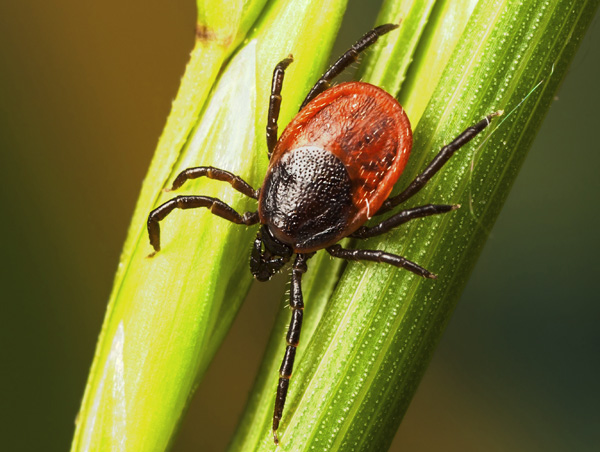
One of the most common types of ixodid ticks, found throughout almost the entire territory of Russia, is the taiga tick.
In Russia, ticks hunt from early spring to late autumn, but there are periods of special activity. Spring-early summer and late summer-early autumn are known as the time when ticks most often attack humans. In the spring, after the snow melts, adult parasites come out of hibernation and get out in search of prey. They are hungry and very aggressive.
In the middle of summer, especially in dry times, parasites are forced to hide from the sun in damp places, climbing the grass only at night. Therefore, you should not count on the fact that night time will be able to protect you from a tick attack. In this case, in the heat of the day, there is much less chance of picking up a parasite. The daily activity of bloodsuckers increases again at the end of summer, when it is still warm, but there is no heat and lack of moisture, and you can again wait for the victim.
It is interesting
There is an opinion that ticks do not attack in rainy weather. During rains, the activity of ticks really decreases, however, it is worth noting that drizzling rain will not interfere with parasites - sometimes, on the contrary, increased humidity after a strong heat will create comfortable conditions for lying in wait for the victim.
What sense organs help ticks find prey?
In order to understand how ticks attack a person, let's take a closer look at the sensory organs that help them detect a potential victim. For these parasites, the sense of smell and touch are most important, since ticks see very poorly. Some species do not have eyes at all, but light-sensitive cells are present under the cuticle.
Regarding the presence of hearing in these blood-sucking parasites, acarologists still have conflicting data. Ticks pick up the noise and vibrations of the soil, but do not show active actions, which indicates that this irritant is not the main one.
But the sense of touch and smell play an important role in finding food. The organs of touch are sensilla hairs located throughout the body and paws of the tick. They transmit information about the surrounding world: temperature, humidity, air composition. The structure of all sensilla is similar: they consist of a cuticular hair or bristle, receptor cells, they are called bipolar sensory neurons, and auxiliary cellular elements - wrapping cells.
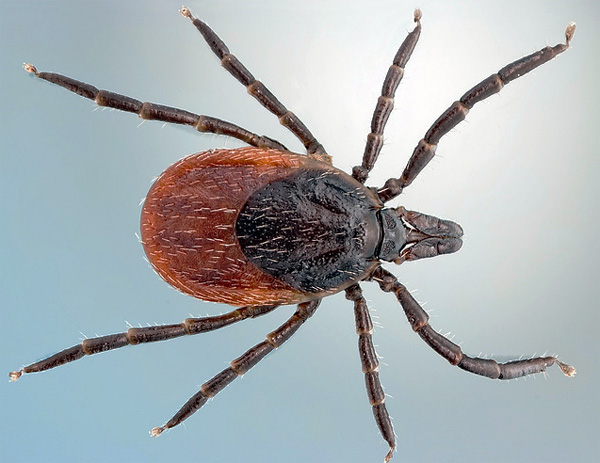
Sensilla (hairs) are the organs of touch and smell of the tick.
The main olfactory receptor that helps to choose a prey is the Haller's organ, located on the front pair of legs of the tick. It is a recess, closed with a lid with a small hole.This recess is called the olfactory capsule and contains porous sensilla that are sensitive to carbon dioxide exhaled by future prey.
Near the opening of the capsule is a recess - the second section of Haller's organ. It contains an anterior group of sensilla, which includes one porous, two striated, two conical, and two fine hairs. Behind the capsular opening are the postcapsular sensilla. Depending on the structure, sensilla perform different functions.
The largest hairs of the first group are sensitive to nitrophenol, which is the main component of the sex pheromones of ticks. In the same group there are bristles that react to fatty acids, lactone, ammonia and other compounds that are components of the smell of the victim, which the parasite can sense from a distance of up to 10 meters. And with the help of furrowed and postcapsular sensilla, the tick can pick up infrared radiation from prey, perceived from a distance of up to half a meter, and feel the level of environmental humidity.
Thus, we can conclude that the tick practically does not see and does not hear its prey, but finds it by smell, carbon dioxide released and thermal radiation.
Is the tick hunting or accidentally falling on its prey?
The choice of victim depends on tick development stages. The larvae live on the ground, in leafy litter, crawl into animal burrows and feed mainly on the blood of rodents and birds.
Older nymphs can climb grass and attach themselves to larger warm-blooded animals such as hares, badgers, foxes, squirrels, cats, dogs, but can also attack humans.After a walk, a pet may well bring such a “passenger” on itself, which, without having time to stick to the animal, will safely move onto a person.
More dangerous is the adult stage - an adult arthropod. It is more aggressive, can travel longer distances, climb grass and bushes higher than its younger relatives, and The more hosts a parasite has, the more likely it is to carry a dangerous infection.
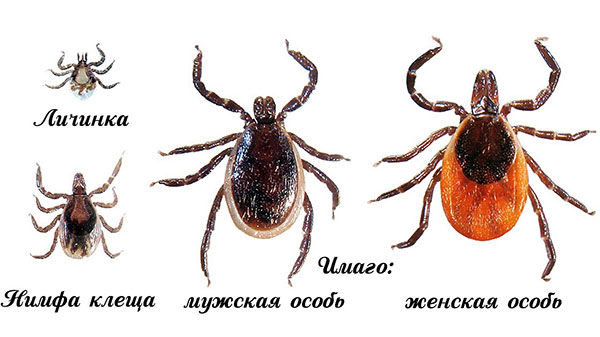
Stages of tick development.
The search for a victim by a tick consists of two stages. The first is orientation in space. The tick studies the environment: temperature, humidity, air composition, and climbs the grass to the most comfortable place.
Depending on the species and stage of development, parasites lie in wait for their victims in grass and bushes at heights ranging from a few centimeters to a meter. Ticks are located in the chosen place and wait for the victim, stretching out the front pair of legs, where the claws are located, with the help of which they are attached and held on the host's body.
It is worth noting that here we are not talking about the “attack” of ticks on a person or an animal, since they are not physically fit to jump, run fast, and, moreover, fly. All that a tick can do is to choose a good place for hunting and lie in wait (passively or actively) for its prey in order to cling to it in time when it comes at a sufficient distance.
It is interesting
Ticks do not wait for their victims on tree branches. They do not climb as high, so do not be afraid that the parasite may jump or fall from the tree.
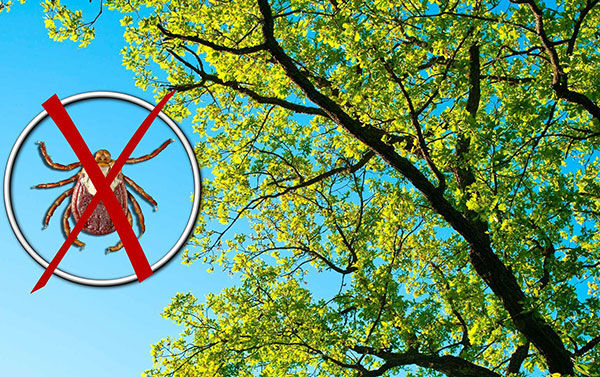
Ticks do not climb tree branches, but wait for their prey in the grass or on low bushes.
When the tick finds its prey, the second stage begins - from passive, it turns into an active lieutenant. It turns in the direction from which the stimuli are coming and perceives them, making oscillatory movements with the front pair of legs, until contact with the host is made.
In addition to passive and active lying in wait, some types of ticks can pursue the victim. The boundary between these types of behavior is conditional, since those species that are inherent in lying in wait can also go hunting. This happens if the host has not appeared in the immediate vicinity, but continues to be captured by receptors. Then the tick can descend or fall to the ground, crawl and cover a distance of 5-10 meters to the selected animal or person.
It is interesting
During passive waiting, the tick loses moisture. To restore water balance, he has to go down from the grass to places with high humidity, for example, in leaf litter or soil cracks. There, the tick absorbs water from the entire surface of the body.
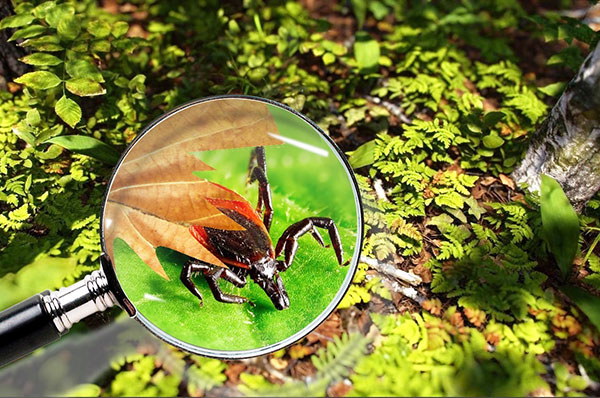
Without waiting for the victim, the tick descends into the leaf litter to restore the loss of moisture.
Having found the victim, the tick clings to it. Hooks, spikes and bristles located on the legs help the parasite to stay on clothes, they also help the tick to move around the host and stay in place when trying to shake it off.
What does a tick do after it gets on a person
The tick is not sucked right away. He needs to choose a zone on the body where the skin is thinner and it is easier to reach the blood vessels. This search can last about two to three hours, especially in clothing that blocks access to exposed areas of the body.
Most often, ticks stick in the following places:
- Armpits;
- Groin;
- Breast;
- The inner surface of the knees;
- The area behind the ears;
- Head and neck.
The specific structure of the oral apparatus of this arthropod contributes to a painless and imperceptible for the victim, but very strong attachment of the parasite at the site of the bite. On the head of the tick, which is called the gnathosoma, there are tools with which the parasite cuts the host's skin and attaches to it. These are pedipalps, chelicerae, and a proboscis-hypostome with sharp teeth directed backwards.
The body of the tick is called an idiosoma and is covered with a cuticle that can stretch to accommodate the drunk blood. Thus, the parasite is able to increase many times in size.
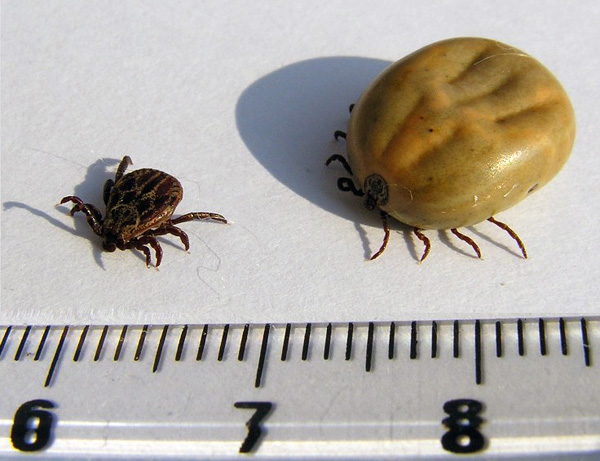
Feeding on the blood of the victim, the tick increases in size several times.
During the bite, the tick cuts the skin with chelicerae, at the same time introducing the proboscis into the resulting incision. This process takes about 15-20 minutes, and as a result, the entire gnathosoma is immersed in the wound.
The hypostome is covered with saliva, which has an anesthetic effect, contains anticoagulants that interfere with blood clotting, and protects against the immune response of the affected organism. The hooks of the proboscis directed in the opposite direction and the outgrowths of the chelicera cases work as anchors, helping to firmly gain a foothold in the wound and feed on blood from several hours to a week.
On a note
Thanks to the mechanism of fixing the oral apparatus in the wound, when you try to pull out the sucked tick sharply, its body will simply come off, and the gnathosoma will remain inside the skin. Therefore, it is necessary to remove an already attached parasite with extreme caution.
What is the danger of a tick bite: the diseases that it carries
Tick bites are very dangerous, because with saliva, viruses, bacteria and protozoa can enter the bloodstream, which cause such serious diseases as tick-borne encephalitis, borreliosis and many others. And the longer the encephalitic or borreliosis tick eats, the more likely it is to be infected. In addition, there are cases when a person, combing the bite and crushing the tick, rubs the infected saliva into the wound himself.
The consequences of infection are severe. bacteria tick-borne borreliosis attack the nervous system, internal organs and musculoskeletal system, often paralysis, depression, insomnia, hearing loss occur. The disease is treated with antibiotics, and an advanced form can lead to death.
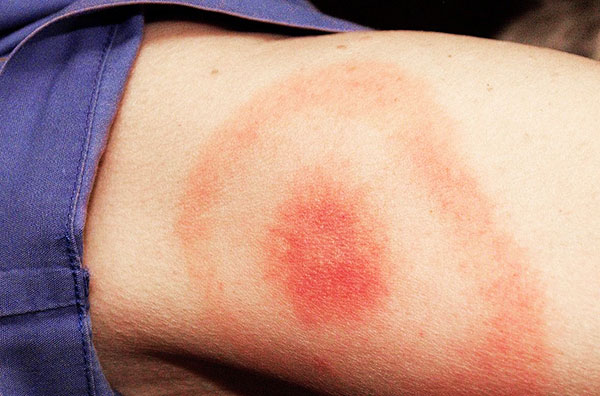
The first sign of tick-borne borreliosis is ring-shaped reddening of the skin at the site of the parasite bite.
On a note
Tick-borne borreliosis (aka Lyme disease) is the most common disease carried by ticks. Depending on the region, the probability of getting infected can be very high! But, despite this, everyone has heard of tick-borne encephalitis, which infects only about 6% of ticks, even in regions that are epidemiologically disadvantaged in terms of TBE.
Tick-borne encephalitis is caused by a virus that infects the nervous system, brain and spinal cord, and leads to severe mental and neurological complications, and even death. In addition to the bite of a tick, encephalitis can be contracted through the thermally unprocessed milk of an infected cow or goat. There is no specific cure for this terrible disease, only supportive therapy is provided.
An effective defense can be tick-borne encephalitis vaccinationto be started in the fall.Re-vaccination is carried out after 1-3 months, then revaccination in a year, then repeated every three years.
Rules of conduct in nature
To avoid a tick bite and dangerous consequences, you must adhere to the following simple rules of conduct in the field:
- Use plain light-colored clothes - it will be easier to notice the attached parasite on it;
- Limit access to the body as much as possible. You should choose clothes with a tight-fitting collar and cuffs, tuck the jacket into pants, and pants into socks, use a hat. You can use special anti-tick suits;

To avoid tick bites, wear clothing that covers all parts of the body, and do not forget about a hat.
- Try to avoid places where ticks are likely to be. These include clearings with tall grass, animal trails, pastures;
- Every 10-15 minutes, clothing should be inspected, and at halts, the whole body should be carefully checked;
- Use tick protection products. Today, there are a large number of drugs, which, depending on the type of exposure, are divided into repellent, acaricidal and combined. Repellents repel ticks, acaricides kill, and combined ones act in two directions at once.
Compliance with the above methods of protection will help protect yourself from the negative consequences of a personal meeting with a forest parasite.
The mechanism of tick attack and structural features of their oral apparatus

